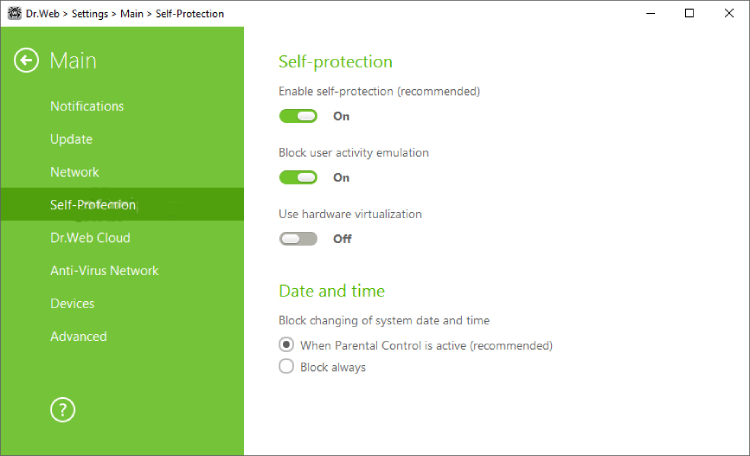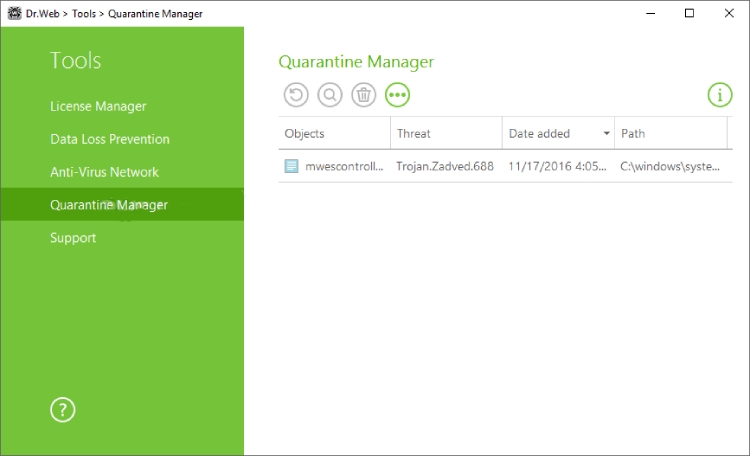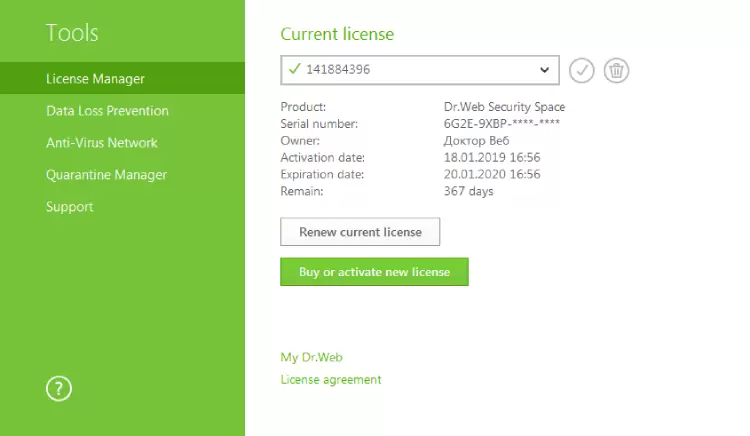Is Dr.Web A Good Antivirus?
Dr.Web was introduced to the world back in 1992 and has been around for almost three decades. This Russia-based provider is fully compatible with Windows, macOS, Linux, and Android. However, it doesn’t really have what it takes to compete with the like of Kaspersky, Bitdefender, or Norton. First of all, it hasn’t been properly tested by independent labs for a long time, and the user interface leaves a lot to be desired.
On top of that, it lacks some advanced security features. On the other hand, Dr.Web includes some unique and useful extras that are very easy to use and have proven to be effective. Plus, the pricing policy is quite user-oriented and competitive, with attractive deals on two- and three-year subscriptions. So, is Dr.Web a good antivirus, or not? It is, most certainly, outdated, but it does have a couple of trumps up its sleeve. YOu might consider some other antivirus solutions.
In our detailed Dr. Web review, we’ll tell you everything there is to know about this product. We’ll go over the pros, cons, available packages, protection capabilities, and real-world performance. At the very bottom, you’ll find our team’s final verdict and a quick FAQ section with answers to the most popular questions.
Pros and Cons
We like:
- Competitively priced; offers decent value
- Compatible with Win, Mac, Linux, and Android
- Includes some useful extra features
- Thorough, customizable scans
- Decent customer support
We don’t like:
- Lacks independent lab tests
- A cluttered user interface
- An outdated firewall
- Not available on iOS
Highlights
- Available on all major platforms (except for iOS)
- Affordable yearly subscriptions
- Advanced security features
Dr.Web Features: How Does Dr. Web Work?
With the pros, cons, and highlights out of the way, let us see what Dr. Web has to offer in terms of the feature set. We’ll take a look at the firewall, ransomware protection, malware protection, and other security modules. We’ll also go over the software’s scanning options and the CureIt tool that can be quite effective against most threats. Overall, the list of features is decent, but not as big as in some of the leaders like Avast and Kaspersky.
That’s well compensated by the below-average prices and the wide platform coverage. On top of that, Dr. Web is quite customizable, and you can change certain settings to your liking.
Malware Protection

Dr. Web is a traditional antivirus product, meaning it runs an antivirus engine to keep outside threats at bay. It works in real-time and uses an extensive database of known malware when dealing with potentially dangerous files/apps. This engine is updated 24/7: every time the Web Cloud (Dr. Web’s database) changes/upgrades its virus definitions, you’ll get an automatic update.
On top of that, this software also relies on a heuristic module that focuses on 0-day attacks. The term “zero-day attacks” refers to brand-new viruses that haven’t yet been included in any database. The heuristic module is called the ShellGuard and was introduced by the team relatively recently (in 2018, to be exact). It detects and eliminates potential threats based on their digital signatures.
In the settings, you can define what the apps running on your device are allowed to do. By default, no third-party program can access the HOSTS file, but you can change that. The combination of the good old anti-malware engine and the behavioral analysis approach makes Dr. Web a reliable layer of defense against hackers. If you want to read more about Dr. Web anti-malware core and check its performance in real-world tests, go to “Lab Test Results.”
Scanning Features
In contrast to the more user-friendly software like Avast, Dr. Web is a bit hard to navigate. For example, you won’t find a “Scan” button on the main dashboard. It’s not even available through the tray icon, which is always the case with most rivaling products. Here’s how you can launch a scan: click on Security Center, open the Files and Network menu, and hit “Scanner.”
Dr. Web offers three scans to choose from. We’ve got the Express, Full, and Custom scans, and they can all be launched separately. The scans are in-depth, but they take quite a long time to complete. Furthermore, while most files are scanned immediately, some “heavy” programs took up to 30 seconds to check, and that had a negative effect on the overall OS performance.
What’s even worse, you can’t stop/pause the scanning when it’s busy with those high-impact apps. The Custom scans, in turn, are rather limited. They don’t allow creating new scan types or “fine-tuning” them as you can with Avira and Avast. For the sake of this review, we planted a series of malicious samples, and Dr. Web found them all. Sadly, the number of false positives was higher than we hoped. You can whitelist files you trust, but it’s a bit time-consuming.
Firewall

Dr. Web’s firewall is available on all four platforms (Win, Mac, Linux, and Android). Mainly, it protects the network from unauthorized access. Plus, it prevents any data leaks and keeps sensitive data safe. Whenever it detects potentially malicious connections, the firewall blocks any attempts at accessing the network. It refers to a database of safe, trusted apps, with a so-called “digital certificate.”
Therefore, the programs that are known to be legit can connect to any address/port. And if a certain app doesn’t have a certificate, you can create a rule for it and “tell” the firewall not to block it. To do this, go to Protection Components – Firewall. There, you’ll be able to change parameters for known networks and specify network access for the programs of your choosing.
Thanks to the packet-filtering method, Dr. Web controls every single app on the OS and its access to the internet. It has a log that keeps info about packets sent over the network, making it easier to detect suspicious activity. On the downside – the firewall is overly active, and you’ll see pop-ups quite often. Compared to the modules in Bitdefender and Kaspersky, it’s not nearly as intelligent. Yet, it does a fairly good job of protecting the network.
Ransomware Protection
Ransomware is a type of malware that encrypts user files/folders and demands a ransom for the decryption key. The most advanced types of ransomware can make it impossible to access any file on the system or even launch it. To check Dr. Web’s performance against ransomware attacks, we had to run a series of in-house tests. So, we launched a unique ransomware simulator developed by our team of experts (based in the United States).
Now, since it’s a simulator, no antivirus database has information on it, and that makes it more difficult to detect and eliminate. Dr. Web proved to be a reliable program and detected our simulator almost immediately. Very few rivaling antivirus products could do that, by the way. On the downside, this is the exact reason why Dr. Web has so many false positives.
It flags a lot of legit files and apps, and by raising a long list of alarms, it also managed to detect our ransomware simulator. That makes it difficult for us to evaluate the behavioral engine’s performance. It’s a flexible module, though, and you can hand-pick which files/programs can have access to your data. You’ll find these settings in the Preventive Protection menu.
Dr.Web CureIt

If you’re looking for an independent malware scanner, CureIt might be exactly what you need. It can be downloaded from the official website and doesn’t need to be installed. Just click on the downloaded file, wait for the scan to complete, and check the results. In “Scanning Objects,” you can pick which parts of the system, Dr. Web CureIt should check. Those include boot sectors, RAM, root folders, Windows system files, temp files, rootkits, and more.
The software available on the website isn’t updated automatically. So, make sure to download it again to get all the latest database updates. The standard package will cost you 20 US dollars. You can purchase the product for 1-3 three years and cover up to 50 devices. CureIt is only compatible with the Windows OS, starting with XP and up to Win 10. Both 32- and 64-bit editions are supported.
It doesn’t conflict with any traditional antivirus programs. That means it’s safe to download and run it even if you already have an antivirus working in the background.
Other security features
- The SPIDer Mail Monitor does exactly that – monitors your email in search of potential threats. Those include viruses, spam, and phishing. By exploiting software vulnerabilities, cybercriminals send malicious emails and attachments to infect user computers. The SPIDer module works in real-time and scans emails 24/7. It doesn’t require any effort on your side: the anti-spam starts working automatically.
- Parental Controls, in turn, keep potentially harmful content away from the kids. These tools allow blocking explicit content on the internet and setting time limits on phones and tablets. They are very easy to use and do a decent job of restricting access to unwanted websites. You can also use parental controls to keep important files/folders safe by blocking access to them.
- Data Loss Prevention is another useful extra. As the name suggests, this module encrypts sensitive data. And, it fights malicious code that tries to modify or delete those files.
Lab Test Results
We already talked about our team’s ransomware protection tests. Now let’s take a quick look at how effective Dr. Web is against malware. The biggest problem here is the lack of independent lab test results. The most recent tests date back to 2017 when AV-test evaluated the Security Space product. While it did get 6/6 in Performance, the antivirus failed in the Protection test. With 3.5/6, it lagged behind the leaders.
AV-Comparatives, another big name among independent labs, tested the Android edition in 2019. Dr. Web managed to detect and remove 90% of the planted threats, but, again, couldn’t compete with the best of the best. And that’s pretty much it for the available results.
Performance

On average, Dr. Web needs 1GB of hard-drive space. The RAM expects it to “occupy” up to 500MB, with four to five processes in the Task Manager. While that’s more than the industry average, we didn’t see any noticeable strain on the system during our test. However, as we already said when talking about the scanning options, a full scan can be quite demanding.
The official system requirements are:
- Win XP/later
- macOS 10.7/later
- Linux GNU with kernel 2.6.37 and Glibc 2.13 or later
- Android 4.4/later
- At least 512MB of RAM
- 100MB-1GB of hard-drive space, depending on the package
Dr. Web Pricing and Packages
| Package | Price |
|---|---|
| Security Space | $32 per year |
| KATANA | $32 per year |
| Dr.Web for Android | $7.7 per year |
Free and Trial Version
Dr. Web doesn’t offer any free editions or a money-back guarantee. But, it does provide generous free trials of all the available products. With Dr. Web for Android, you’ll get a 14-day trial. KATANA, in turn, can be used for free for a full month (30 days). Security Space, the most expensive and feature-packed package, also comes with a 30-day trial.
But, if you commit to an automatic subscription renewal/activation, you’ll be able to use it for 90 days. That will also grant a 40% discount for the transition to the paid version.
Dr.Web Security Space

It is the most expensive and feature-packed package. With Dr. Web Security Space, you can protect up to five devices (both desktop and mobile). The list of features is as follows:
- Anti-virus protection
- Firewall
- SPIDer Gate
- SPIDer Mail monitor
- Parental Controls
- Behavioral analysis
- Anti-ransomware protection
- Exploit prevention
- DLP (Data Loss Protection)
- Camera/Mic control (prevents apps from taking control over your webcam and microphone)
- Removable device access restriction (prevents unauthorized access to external devices)
- Dr. Web Cloud
- Dr. Web Portal (a comprehensive service guide)
- Security Center (remote control over the antivirus)
- 24/7 Customer support
- File decryption (helps with recovering encrypted files/folders/apps)
Here’s what it will cost you:
- Dr. Web Security Space for one device: 32USD/year
- DR. Web Security Space for five devices: 80USD/year
Dr.Web KATANA
KATANA is mostly the same as Security Space, but it’s less feature-packed. The biggest difference is the limited platform support. This plan is only available on the Windows OS and can protect up to five PCs. Furthermore, it lacks file protection modules, including parental controls, a firewall, and anti-virus scanning. DLP and camera protection won’t be a part of the deal either.
So, only consider it if you’re a fan of the Windows operating system and don’t need the extra security tools and features. Take a look at the prices:
- Dr. Web KATANA for one device: 30USD/year
- DR. Web KATANA for five devices: 70USD/year
Dr.Web for Android
Dr. Web Security Space for Android is fully compatible with Android 4.4 up to 10 and Android TV 5.0. Yes, it covers not only smartphones but also tablets, smart TVs, and even consoles (like PS4 or Xbox One). The company boasts 140+ million downloads, which is, indeed, impressive. It is very well capable of protecting you against ransomware, phishing, spyware, and keyloggers.
Here’s a list of features that you’ll get with Dr. Web for Android:
- Anti-virus protection
- Parental controls
- Anti-theft (tracks a lost phone and wipes it remotely)
- Anti-spam (keeps email spam at bay)
- URL filter (anti-phishing protection)
- Security Auditor (analyses your phone and offers security solutions)
- Firewall
The prices in 2022 are:
- Dr. Web for Android: $7.7 per year (protection for one single device)
- Dr. Web for Android Life: $45 per year (protection for up to five devices)
A quick note: Android TVs will only get anti-virus protection, a firewall, and a security auditor.
Customer Support
On the official website (in the top right corner), you’ll see a question mark. Click on it, and you’ll get quick access to the support menu. Fans of old-school communication can use the 24/7 phone number to get a hold of the support agents. For the sake of this review, we reached out to Dr. Web and were pleased by how fast and helpful customer service was.
Right below the phone number, you’ll find a link to the forum. It’s quite busy and is available in Russian, English, and French. There’s also a Query Form that you can use to ask a question and submit a file decryption request. Dr. Web also provides a self-support bot. When you click on it, the bot will automatically launch in Telegram. It can check suspicious files/apps, help with some basic stuff, and contact the human support agents.
Last but not least, the Support page includes an impressive list of FAQ and Knowledgebase pages and helpful and easy-to-understand how-to videos. All the “legal stuff” can be found in the Licensing menu. In Self-Support, the company allows registering a serial number, restoring a blocked one, changing the registered email address, and more.
Also, you can contact Customer Support via phone in case you have any queries:
- 8-800-333-7932
- 7 (495) 789-45-86
Dr. Web Antivirus FAQ
The Verdict
If you’re in the market for decent protection on a budget, Dr. Web might be a good purchase. It’s available not only on Win and Mac but also on Linux (and Android). While it lacks some cutting-edge extras, Dr. Web’s set of features is still quite alright. On the downside, the user interface isn’t nearly as polished or easy to use as we’d like it to be.
The lack of consistent third-party tests is another big con, along with the non-reliable firewall module. For the experts, Dr. Web can be a reasonable investment. In contrast, the average home user will be disappointed by the over-crowded interface and outdated navigation. So, you should probably spend your money on a leading antivirus solution like Kaspersky, Avast, or Bitdefender.
